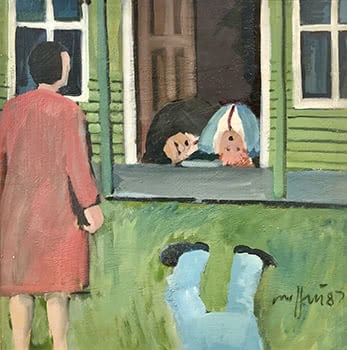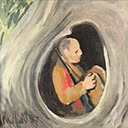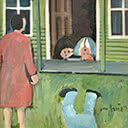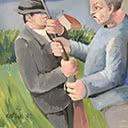The School Teacher Evelyn Gibson Arrives, October 1941 - From the Stanley Graham Series
58 x 58 cm
PROVENANCE
Private Collection, Auckland
Towards the end of 1985, with his own life having settled down a bit, Trevor started to research Stanley Graham the West Coast murderer. He read all the material available on the case but did not go to see the recently released film because 'I did not want to be influenced by it'.
During the school holidays Trevor spent a couple of weeks in 'Hokitika and visited all the relevant sites and the remains of [Stan's] house which the locals burned down' soon after Graham died. 'I was able to speak to people, who if they hadn't known Graham, had certainly met some of the people he killed, so that was interesting'. However, there was a general reticence by West Coasters to talk about the shootings and when Trevor obliquely introduced his name into the conversation while having a drink in the public bar, he was told: 'Bloody good bloke, Stan was. Pity he didn't take more of the bastards with him'. 'The only thing that remains now of where the killings took place is the concrete bases of fireplaces - it's all very spooky; moss grows on the telephone poles, mists rise around you and there seems to be a thousand pairs of eyes on you'.
The year was 1941 and Stanley Graham was a forty- year old farmer living at Koiterangi, near Hokitika. He was a skilled bushman and excellent marksman, but was known to have a bad temper. Mrs Graham was supportive of her husband, although she had been a barmaid in Rakaia and was never really accepted into the community. 'The wives ganged up on her. She didn't get invited to the morning tea parties and things like that'. All was reasonably well until Graham's cowshed was condemned as insanitary by a local dairy factory inspector. One of his cows died and he thought it had been poisoned. Graham and his wife suspected that his neighbours were plotting against him, possibly to try and force them off their land.
In response to Graham threatening one or two neighbours while being armed with a rifle, the local constable arrived at his farmhouse supported by Sergeant Billy Cooper (born and bred in Waikaia) and two constables from Hokitika. The initial meeting with Graham was cordial but soon after they left a neighbour reported that he was seen with a gun. The policemen returned and in what could be summarised as their attempts to take Graham's rifle from him all were shot. Two died on the spot, most unusually from a single bullet. A third died soon after, and the fourth a few days later. A field instructor from the Canterbury Education Board, George Ridley, went to investigate, while being covered by an armed neighbour. Ridley eventually made a nervous move towards Graham and was shot, subsequently dying of his wounds over a year later.
Graham fled into the bush and remained at large for twelve days. This was despite the enlistment of around one hundred policemen, some brought down from Auckland, plus about fifty soldiers and close to fifty locals, some being Home Guardsmen for the period of the War. Graham made two night time shadowy attempts to return to his farmhouse but was spotted on both occasions. Shots were exchanged, and Graham killed two of the locals, but on the second occasion he received a wound in his shoulder, but still escaped.
Eventually he was sighted and shot at relatively close range. While injured on the ground he said, 'You've got me, I've paid in full'. Stanley Graham died the following day to be eventually recorded as killing seven men. Until the Aramoana murders in 1990, Graham had the dubious distinction of committing the most murders in New Zealand's history.
The first showing of the Stanley Graham series was at the Carnegie Gallery, in the Carnegie Centre, Dunedin, in August 1987. It was a joint exhibition with Bing Dawe and Barry Cleavin, with nine or ten of Moffitt's works on show. None of his paintings sold, but unbeknown to anyone associated with the exhibition, the daughter of George Ridley, the Education Board field instructor shot by Graham, turned up at the preview: I'd gone outside for a cigarette and Grahame Sydney [the artist] came rushing out and said, 'Oh my God, there's all sorts of things happening in there. This woman screaming and yelling. We asked her if she'd like to meet you, and the next thing she went past at about 300 mph and disappeared into the night'. I never heard of her since. But she apparently was highly upset at being confronted by a couple of paintings of her father being shot. It was a bit insensitive I suppose, but I didn't know she was going to be there.





